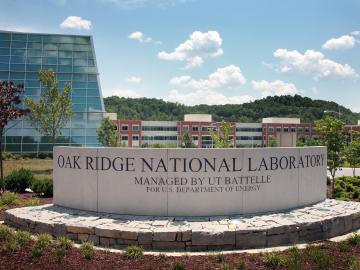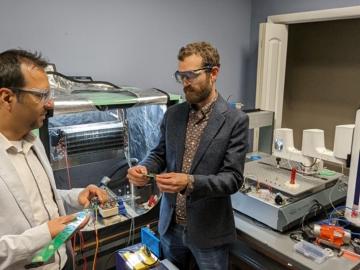
Filter News
Area of Research
- Advanced Manufacturing (5)
- Biology and Environment (21)
- Computational Biology (1)
- Computational Engineering (2)
- Computer Science (2)
- Energy Frontier Research Centers (1)
- Energy Science (37)
- Fusion and Fission (7)
- Fusion Energy (2)
- Isotope Development and Production (1)
- Isotopes (10)
- Materials (94)
- Materials Characterization (1)
- Materials for Computing (14)
- Materials Under Extremes (1)
- Mathematics (1)
- National Security (17)
- Neutron Science (25)
- Nuclear Science and Technology (4)
- Quantum information Science (2)
- Supercomputing (29)
- Transportation Systems (1)
News Type
News Topics
- (-) Biomedical (28)
- (-) Chemical Sciences (48)
- (-) Clean Water (16)
- (-) Cybersecurity (20)
- (-) Isotopes (25)
- (-) Materials Science (90)
- (-) Nanotechnology (41)
- (-) National Security (21)
- 3-D Printing/Advanced Manufacturing (82)
- Advanced Reactors (25)
- Artificial Intelligence (51)
- Big Data (25)
- Bioenergy (42)
- Biology (47)
- Biotechnology (14)
- Buildings (36)
- Composites (23)
- Computer Science (105)
- Coronavirus (28)
- Critical Materials (23)
- Education (3)
- Element Discovery (1)
- Emergency (1)
- Energy Storage (75)
- Environment (86)
- Exascale Computing (14)
- Fossil Energy (2)
- Frontier (17)
- Fusion (26)
- Grid (38)
- High-Performance Computing (44)
- Hydropower (6)
- Irradiation (2)
- ITER (5)
- Machine Learning (27)
- Materials (96)
- Mathematics (3)
- Mercury (5)
- Microelectronics (1)
- Microscopy (28)
- Molten Salt (8)
- Neutron Science (81)
- Nuclear Energy (47)
- Partnerships (33)
- Physics (30)
- Polymers (23)
- Quantum Computing (18)
- Quantum Science (42)
- Security (13)
- Simulation (19)
- Space Exploration (13)
- Statistics (2)
- Summit (30)
- Transportation (62)
Media Contacts

Two different teams that included Oak Ridge National Laboratory employees were honored Feb. 20 with Secretary’s Honor Achievement Awards from the Department of Energy. This is DOE's highest form of employee recognition.

In a win for chemistry, inventors at ORNL have designed a closed-loop path for synthesizing an exceptionally tough carbon-fiber-reinforced polymer, or CFRP, and later recovering all of its starting materials.

ORNL climate modeling expertise contributed to a project that assessed global emissions of ammonia from croplands now and in a warmer future, while also identifying solutions tuned to local growing conditions.

Four ORNL teams and one researcher were recognized for excellence in technology transfer and technology transfer innovation.

Corning uses neutron scattering to study the stability of different types of glass. Recently, researchers for the company have found that understanding the stability of the rings of atoms in glass materials can help predict the performance of glass products.

Four researchers at the Department of Energy’s Oak Ridge National Laboratory have been named ORNL Corporate Fellows in recognition of significant career accomplishments and continued leadership in their scientific fields.

Four scientists affiliated with ORNL were named Battelle Distinguished Inventors during the lab’s annual Innovation Awards on Dec. 1 in recognition of being granted 14 or more United States patents.

Caldera Holding, the owner and developer of Missouri’s Pea Ridge iron mine, has entered a nonexclusive research and development licensing agreement with ORNL to apply a membrane solvent extraction technique, or MSX, developed by ORNL researchers to mined ores.

Guided by machine learning, chemists at ORNL designed a record-setting carbonaceous supercapacitor material that stores four times more energy than the best commercial material.

Researchers at ORNL have been leading a project to understand how a high-altitude electromagnetic pulse, or EMP, could threaten power plants.


